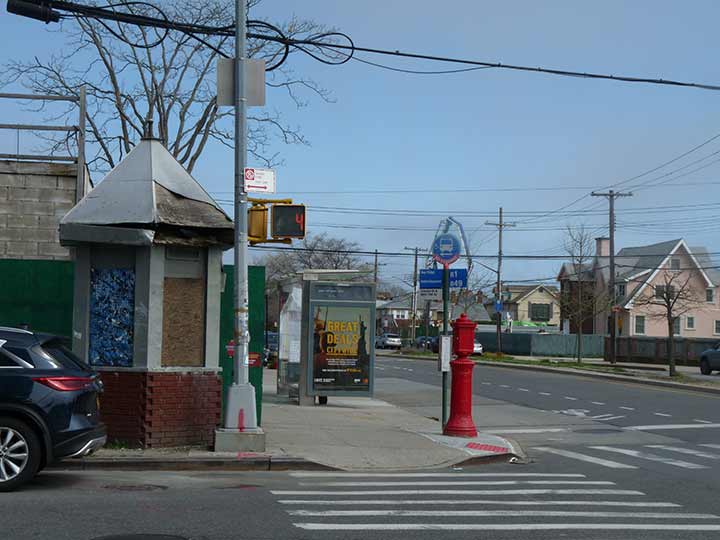
I have always thought that Brooklyn should have a somewhat wary, adversarial relationship with Manhattan, albeit a cordial one. With that in mind I had no idea why a beach and a neighborhood at the southern end of Brooklyn should be named for Manhattan. Manhattan Beach doesn’t even face Manhattan — at least Manhattan can be spotted from Greenpoint’s Manhattan Avenue. When wealthy banker and railroad nabob Austin Corbin built the Manhattan Beach Hotel and the Manhattan Beach Railway that brought the well to do to the shore, though, it must have seemed perfectly natural to bring the big city to the wilds of far-off Gravesend Town. Corbin constructed the Manhattan Beach Hotel and the adjacent Oriental (i.e. east of Coney Island) Hotel in the late 1870s. President Ulysses S. Grant officiated at the Manhattan Beach Hotel opening, which featured historic tableaux, fireworks, and a performance of the Manhattan Beach March by John Philip Sousa. President Rutherford B. Hayes, meanwhile, did the opening honors at the Oriental Hotel in 1880.
While the two hotels did not survive the 1910s (neither did the Manhattan Beach Railway, which became the Manhattan Beach Branch of the Long Island Rail Road when Corbin became the LIRR’s President) residential development began to take place in 1908; the Manhattan Beach Improvement Company, owned by developer Joseph P. Day, purchased Austin Corbin Jr.’s shares and laid out streets on the spit of land that lay between Sheepshead Bay and the Atlantic Ocean, giving them British-sounding names to impart class. Most apartment buildings have been prohibited from zoning regulations since the early days.
Corbin, who was virulently anti-Semitic (he likely despised all races but white, and all nationalities but Anglo-Saxon) is ironically honored by Corbin Place in an overwhelmingly Jewish neighborhood.
For some time I was mystified by a pair of booths in the neighborhood, this one at West End Avenue and Oriental Boulevard and another one at Shore Boulevard and Exeter Street, at the Ocean Avenue footbridge. I was stymied finding out their origin, until I discovered this article in a blog by Joseph Enright called The View From Argyle Heights, which cites Forgotten NY in the credits. Make a sandwich…the article is lengthy and goes into the overall history of Manhattan Beach. Most pertinently, it states…
The booths were erected in 1946 following a home invasion in the area which provided the denouement for what angry residents described as “500 crimes in the past five years”. The NYPD countered there had only been 100 burglaries in the area in the previous year, but admitted they had made only one arrest. Two of those burglaries targeted a home located at the corner of Hampton and Coleridge Streets.
In addition, a famed defense attorney, Samuel Leibowitz, lived in Manhattan Beach:
Leibowitz was a famous defense attorney specializing in murder cases who represented prominent thugs, like Al Capone and Bugsy Seigel, as well as hapless commoners. By 1933, he had an incredible success rate of 78 acquittals and one hung jury in defending 79 homicide defendants. So the International Labor Defense, the Communist Party’s legal arm, reached out. They were representing nine African-American youths accused of raping two white women on a freight train in Scottsboro, Alabama. Leibowitz was no Commie. Still, after studying the case he readily agreed to head south to assist (pro bono) in defending the group – ever after to be known as The Scottsboro Boys.
Unfortunately, the abandoned booth at Westend and Oriental has disappeared; but the one on Shore Boulevard is still intact, next to the wood pedestrian bridge across Sheepshead Bay.
As always, “comment…as you see fit.” I earn a small payment when you click on any ad on the site.
5/8/23


4 comments
By the time those booths would have been erected, Sam Leibowitz was a judge in the Brooklyn criminal trial court, and my father told me that Leibowitz used to throw the book at defendants who were guiltier than sin but hadn’t had the decency to make a plea deal. My father believed it was that Leibowitz, from years of criminal defense work, knew when defendants were just busting chops by going to trial, and when they had legit cases.
Leibowitz represented various members of fMurder, Inc. during his shyster period.
There is also a Brooklyn neighborhood not for south from Prospect Park known as Manhattan Terrace, and that is also nowhere near Manhattan itself.
Back in the late 50s, my Mother became very friendly with the policeman who was stationed at the West End Avenue booth, and we got to hang in and around it. I remember standing on the electrical junction box, on the northern exterior, so I could look into the windows.